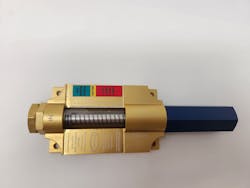A DP Indicator for Smaller Applications

To determine whether a filter is functioning correctly, fuel handlers rely on differential pressure (DP) readings.
The differential reading reflects how clean the filter element in the housing is. In other words, explains Jim Gammon, president at Gammon Technical Products, says that as a filter plugs, it requires more force (pressure) to push the fuel through, which is seen as pressure drop.
Gammon Technical Products, an aviation fuel quality control, refueling and handling equipment manufacturer that manufactures more than 3,000 products and components in the United States, offers the Mini Gammon Gauge to assist fuel handlers with DP readings.
The Mini Gammon Gauge from Gammon Technical Products isn’t really “a gauge” that reads actual pressure. Rather, the Mini Gammon Gauge is a differential pressure (DP) indicator that reads the difference between the pressures at the fuel filter inlet and outlet.
“Everyone calls DP indicators ‘gauges’ because they are so similar,” says Gammon.
Differential pressure is indicated as “psid.” If the inlet pressure is 287 psi and the filter outlet pressure is 277 psi, the gauge reads “10 psid.” It would have the same reading if inlet pressure is 17 psi and outlet is 7 psi.
The actual system pressure (psi) has no effect on the Mini Gammon Gauge.
The Mini Gammon Gauge was first introduced in 2017, about 50 years after the original Gammon Gauge. Jim Gammon’s father and company founder Howard Gammon, who Jim refers to as “the father of aviation fuel quality control”, developed a wide range of products to fill the needs of the aviation fuel handling industry. The Sampling Probe was first, followed by the MiniMonitor and Gammon Gauge in addition to many other products.
“The Mini Gammon Gauge was invented to provide a less expensive alternative to the original Gammon Gauge,” Gammon says. “The problem was that the original gauge is expensive to make. On a large filter housing, costing many thousands of dollars, this is reasonable. On a small filter, it can cost as much as the small filter housing.
“The industry needed a smaller, less expensive, yet high quality differential pressure indicator for small filter vessels,” he continues. “For example, the Gammon Gauge is used on filters up to 2,500 gpm (gallons per minute) in refineries and airports, and typically 300-800 gpm for airliners, but when refueling a private aircraft, the flow rates are typically under 200 gpm for jets and 50 gpm for smaller aircraft.”
While meeting the needs of smaller applications, the mini version is made to the same standards.
“Our manufacturing standards are based on always being the best possible for the price,” Gammon says. “For a piston-type DP gauge, we machine our clearances to be no more than about 0.0002” at any temperature. A piece of paper is about 0.003” thick, about 15 times of the clearance we have. Why is this important? Because any fuel that gets past our piston goes downstream and into the aircraft, having never passed through the main filter vessel, we want that amount of fuel at an absolute minimum. We estimate bypass to be less than a drop per 100 running hours.”
Reading the differential pressure requires no math.
“It is direct reading,” Gammon says, so the possibility of error is minimized.
According to Gammon, the Mini Gammon Gauge provides a simple, inexpensive and reliable way to confirm the condition of the element or elements inside a filter vessel.
“This is important to provide uninterrupted high fuel quality,” he says. “It also alerts you to a problem. If suddenly your DP increases, you got dirt that should not be there, and it is imperative that you check the fuel to see if it is in any way cross-contaminated with another fuel.”
Gammon Technical Products has been selling the Mini Gammon Gauge primarily to Facet and Velcon, manufacturers of small filter vessels in the industry. They sell the filters to customers who install them at the airport or onto a refueler vehicle destined for an airport.
Most commonly, the Mini Gammon Gauge can be found in use at small airports or by small operators at larger airports.
“Our standard Gammon Gauge is on about 90 percent of all large filter vessels on larger facilities, around the world, to include China and Russia,” he says.
Maintaining the Mini Gammon Gauge involves periodically removing the filter and blowing it out with compressed air. Depending on its use, that can be done annually or over longer time frames.
“The filter is a sintered S/S filter, sort of a rigid metal sponge,” he says. “It stops any dirt that could jam the piston. A dirty gauge filter doesn’t cause an error in the reading, it just causes a slow response.”
The Mini Gammon Gauge can be used with aviation fuels, light oils, diesel or gasoline.
The GTP-9739 Mini Gammon Gauge Mounting Kit allows the Mini Gammon Gauge to be installed on either the Velcon VF-61 or Facet VF-22, if predrilled and tapped.
Since the introduction of the Mini Gammon Gauge in 2017, the option of a differential pressure switch was added to trigger an alarm or stop flow. If differential pressure suddenly increases or a facility is operated without personnel monitoring the differential pressure, filter element failure can occur.
This switch adds differential pressure control at a low cost using a non-powered proximity switch. It’s ideal for use in a programmable logic controller (PLC) and relay-controlled systems.
Differential Pressure Gauges for Fuel Filters
The Energy Institute (EI) created a video illustrating the importance of differential pressure.
Every drop of fuel delivered to an aircraft is typically cleaned down to a few microns. Dirty fuel can impact aircraft operations.
To determine whether a filter is functioning correctly, a differential pressure (DP) gauge is used.
As trace levels of dirt accumulate on filter media, there is a progressive rise in DP. Larger debris or a large volume of water hitting the filter may cause a more sudden increase in DP. An increase in flow rate through a filter causes an increase in pressure at the filter inlet.
A steady gentle increase in DP is normal. It means trace levels of dirt – or for filter monitors, water — are gradually accumulating on the filters.
A rapid rise in DP means something has blocked the filter.
A large drop at the same flow rate means the restriction to fuel flow has been reduced. Something has happened.
Source: Differential Pressure Gauges for Fuel Filters video by the Energy Institute
About the Author
Rebecca Kanable
Assistant Editor
Rebecca Kanable, a veteran journalist, worked with Endeavor Business Media's aviation group from 2021 to 2024 as assistant editor of Airport Business, AMT and Ground Support Worldwide. She previously worked for various publications, including trade magazines and newspapers.
